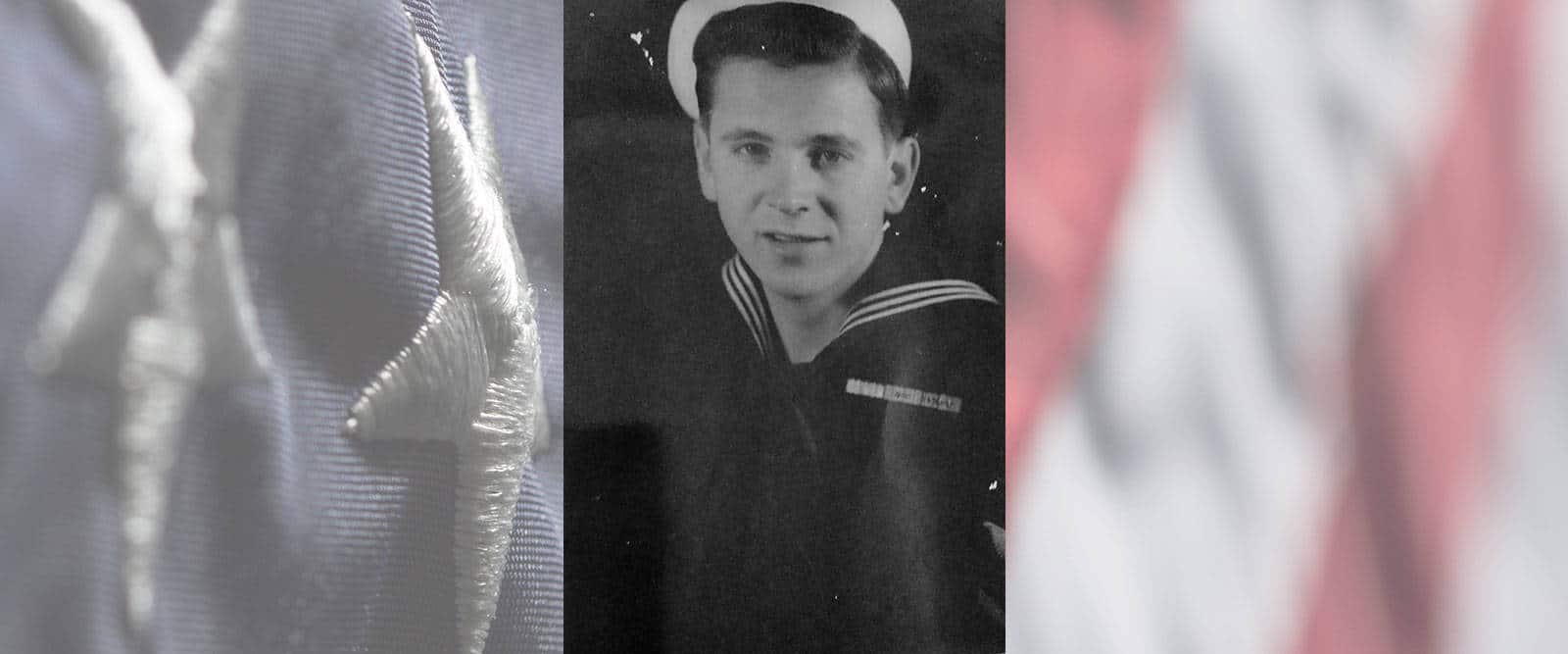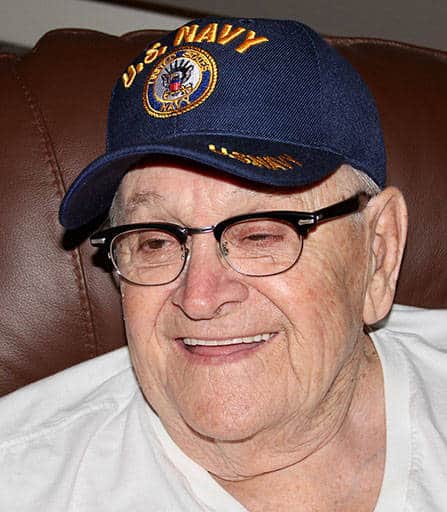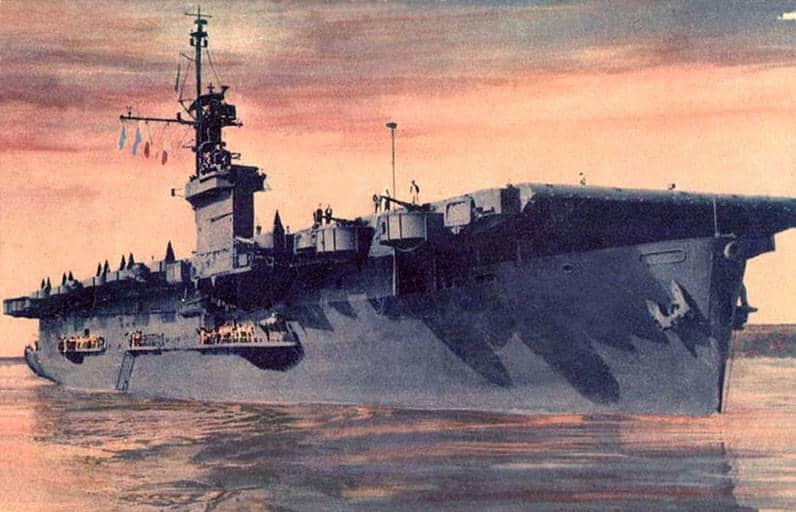U.S. Navy World War II Chicago, IL Flight date: 09/13/17
By David Adams, Honor Flight Chicago Veteran Interviews Volunteer
In spring of 1943 at the age of 17 while still in his third year at Lane Tech, Carl persuaded his mother to let him enlist in the Navy. She would sign for him only if he agreed not to volunteer for submarines. Carl agreed and was inducted on March 22, 1943 reporting to Great Lakes for basic training, “boot camp” as he calls it. He remembers wanting to join the Navy because “I liked to eat as a kid and I thought I would have a better chance in the Navy.” As it turns out he was right!
After basic he reported to the Naval Station in Norfolk, Virginia for advanced training, and was attached to the U.S. Marines to learn how to man a 40-millimeter anti-aircraft gun. He figured as a “loader” he would have a good chance to end up on a ship. Carl’s next assignment was in San Francisco where he waited to join a Marine unit headed for the Pacific theater. Before he could ship out he came down with pneumonia and the unit left without him. He was then assigned to the USS Kadashan Bay (CVE-76). It was a Casablanca class escort carrier named for Kadashan Bay, Alaska and was launched in December 1943 at Vancouver, Washington. The Casablanca class had a larger and more useful hangar deck than previous ships. Unlike larger carriers which had extensive armor, protection was limited. Their small size made them useful for transporting assembled aircraft of various sizes, but fighters were limited to smaller and lighter aircraft such as the Grumman F4F Wildcat. The F4F is the same fighter Butch O’Hare flew claiming five victories and making him the Navy’s first Ace and Medal of Honor recipient.
While standing by to depart from San Diego in May 1944, a Navy old timer confided to Carl that by the looks of the carrier, “it could go over in a stiff wind” but fortunately it didn’t, and even survived a Kamikaze direct hit some months later. Carl was “interviewed” for a job on the Kadashan Bay and said, “I want to be a cook”. Carl stressed that he had worked as a short order cook back in Chicago so the Navy agreed and sent him to the six-week “cooks and bakers” school in Bremerton, Washington. He earned the rank of ship’s cook second class (SCB2c). Soon after joining the 900 sailors and airmen aboard the Kadashan Bay, Carl remembers earning his “sea legs.” While preparing chili in rough weather, he got a whiff from the bubbling pot, and went up on deck, seasick. He never got seasick again and still eats chili today! Shortly after this, Carl was assigned to the butcher shop even though he knew nothing about butchering. He remembers a seasoned, experienced butcher said, “Don’t worry, I will teach you.” He did and Carl turned his new skills into a lifelong occupation.
Carl’s duties extended beyond the galley and butcher shop. Trained on the 40-mm gun as a loader he fulfilled those duties during general quarters and stood watch on the bridge when assigned. He remembers never failing to wake up for the midnight to 4 a.m. watch. “They got you up, no question about it”. He also recalls that being a cook had certain advantages like never standing in line at the barber shop or sorting laundry, thanks to a couple of lamb chops or steaks.
In early September 1944 Carl’s carrier launched a pre-invasion air attack against enemy positions on Peleliu in the Palau Islands. Ground forces, mostly Marines, landed on September 15 to gain control of the island for an air base to support the Philippine operations. After its mission was concluded, the Kadashan Bay steamed toward the Leyte Gulf on October 14. Fighting raged on Peleliu for 73 days before the island was secured at the end of November. The high casualty rate of the operation exceeded all other amphibious operations during the Pacific War.
Carl’s carrier, along with five others in its carrier group, entered Leyte Gulf on October 21. Four days later one of the Kadashan Bay’s patrol planes sighted the Japanese fleet off the island of Samar and thus began the Battle off Samar, a part of the Battle of Leyte Gulf which raged from October 23 through 25. It was the largest naval battle ever fought.
The Kadashan Bay’s next engagement was in support of the Luzon landings in January 1945. This battle saw the first organized use of Kamikaze aircraft by the Japanese. As soon as the Kadashan Bay arrived off Luzon on January 8 its airplanes began an early morning attack. Later that morning Kamikazes attacked the carrier. One hit it at mid-ship below the bridge. Carl remembers that it just missed the fuel stores but crashed directly into the crew sleeping quarters where he and many other sailors slept. Everyone was at general quarters. Carl happened to be in the butcher shop and had to wait several hours before he could go on deck since damage control procedures required all compartment doors be sealed. He remembers going to his crew compartment which was flooded and seeing the remains of the Kamikaze airplane and pilot inside. He and others got a piece of the airplane as a souvenir. His carrier was taken off line, temporarily patched up, sent to San Diego for overhaul and return to duty. Carl recalls ferrying aircraft and troops among the Pacific islands for months. The Kadashan Bay was awarded two battle stars for its exploits and as a part of Taffy 3, the carrier group engaged in the Battle off Samar, a Presidential Unit Citation. Carl is justly proud of his ship!
At the end of the war in August 1945, the Kadashan Bay was converted to a troop ship for repatriation of soldiers back to the States in support of the “Magic Carpet” fleet. Carl was still in the butcher shop and remembers having lots of help from the soldiers going home. Carl was a supervisor from thereon out. The hangar deck was repurposed and Carl remembers a big movie screen installed and cooking steaks for the troops to enjoy on their way home. After returning to San Diego in December it left port in January 1946 headed for Boston and decommissioning. Carl thought he would go with the ship, but, no, the Navy had other plans. He was transferred to the light cruiser USS Topeka instead. For the next five months, he served on the Topeka. Carl remembers its mission was to support American occupation forces in Japan, China (Shanghai), and in the Central Pacific islands (Manila and Guam).
In May 1946 about six weeks before his enlistment was up and having enough points to return to the States he found himself on shore in Japan looking for a way home. Carl got on a troop ship with other service members. When Carl volunteered for the butcher shop he was told all the cooks positions were filled. Maybe yes, maybe no. Shortly out of port and during the first storm at sea everyone in the galley got seasick except Carl. Thereafter he was in charge of the galley.
Carl mustered out in Chicago on July 11, 1946. He quickly found a job as an apprentice butcher and eventually opened his own butcher shop on the North side which he owned and operated until his retirement in 1985. Carl has one son, two daughters, nine grandchildren, and three great-grandchildren
Carl, we thank you for your faithful service as a member of the Greatest Generation! Enjoy your well-earned visit to Washington, D.C.






